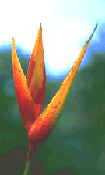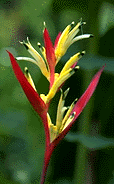An Amazon
Adventure--Heliconias
 |
As you are walking through the jungle in
the Amazon, you will see a very colorful plant. Bright reds, yellows and
oranges are the main color on its' flower. It is a Heliconia. With over 450
species, you are sure to have seen one some where, but not known what it
was. These bright plants can grow to a height anywhere from two to twenty
feet, depending on variety.. The flower, or inflorescence of the Heliconia
stays almost constant, and may last from several days to several months.
|
 |
Heliconias like places with a lot of water,
rich soil, and sunlight. Heliconias grow in places where the temperature stays
at 40c and higher. All of these plants are pollinated by birds or bugs.
Heliconias are popular house plants, and can grow in temperatures ranging from
60 to 76 degrees F.
 |
Psittacorums
The psittacorum (or parrot's
beak)Heliconias are small, dainty and exotically tropical, and resemble the
plant know commonly as Bird-of-Paradise. They bloom abundantly all year.
"Flower" heads appear to be hand painted and glow with brilliant colors. The
psittacorums rarely exceed 3' - 6' in height. The floral bracts of
psittacorums arise from the same point on the stem. Psittacorums don't mind
cool temperatures, but do best in warm, humid areas. |
|
Strictas
The strictas have exotic inflorescence
that mimic shish kebabs of lobster claws. The crimson claws are rigid and
retain their shape and color for weeks. Just as lobsters from different seas
come in an array of shapes, sizes, colors, as do their floral counterparts.
The lobster claws are the most diverse of all the Heliconias. Colors of the
inflorescence range from red, gold, orange, maroon, and green singly or in
combination. Smaller lobster claws are slimmer, shorter stemmed and more
refined in shape than the larger lobster claws. There are several small
lobster varieties whose bracts tend to be flat-sided rather than rounded. |
 |
Below is a list of some of the more popular
Heliconias.
 |
Heliconia rostrata
Traditional and most recognized
Heliconia.
Characteristics: Blooms are pendulous, or
hanging, up to 3' in length with striking red and yellow bracts. Originally
from the Amazon. |
Heliconia psittacorum "Andromeda"
Characteristics: orange-red shading to pink
bracts and white frosting color at base of green tips. The sepals are orange
with distal metallic black or green band and orange tips. Flowers are very long
lasting. Blooms all year.
|
Heliconia "Tortuga": Heliconia
psittacorum x spathocircinata "Tortuga"
Characteristics: bracts fiery orange-red
at base with yellow-gold ends with splashes of red. Sepals golden yellow
with faint green distally. The stem has dark red spots on it. |
 |
 |
Heliconia psittacorum "Lady Di"
Characteristics: Dark rose-red bracts and
cream-yellow sepals with dark green bands and white tips. |
Heliconia psittacorum "Choconiana"
Characteristics: orange inflorescence with
orange bracts and orange sepals with distal black bands and yellow and white
tips. Flowers are long lasting.
Heliconia psittacorum "Rosi"
Characteristics: bracts are rosy-pink
distally and light pink proximally. Sepals are beautiful light green with yellow
cream stripes and dark green bands and cream tips.
Heliconia psittacorum x spathocircinata
"Golden Torch"
Characteristics: extremely large golden
boat-shaped bracts with butter yellow flowers. Inflorescence like rigid golden
sun rays with excellent color, longevity and durable texture. Somewhat larger
than most other psittacorums. Originally from Guyana.
|
Heliconia stricta "Dwarf Jamaican"
Characteristics: one of the smaller
strictas(1 ½' - 3' high). 5" dainty inflorescence that are rose-colored that
evenly grade from pale to deep hues. Each bract is ridged with green on its
upper edge, matching the tiny green and white striped sepals. This is one of
the only Heliconias that can grow in variable temperatures. |
 |
 |
Heliconia stricta "Sharonii"
Characteristics: Red and yellow
inflorescence that stand erect. Foliage is a red wine color on the
undersides of the dark green leaves. |
DEFINITIONS
Rhizomatous--> A horizontal, usually
underground stem that often sends out roots and stems from its nodes. Also known
as rootstalk.
Bracts--> plant part, usually small,
sometimes showy or brightly colored, and located just below the a flower, a
flower stalk, or inflorescence.
Florets--> A small or reduced flower,
especially one of the grasses or composite plants, such as a daisy.
Sepals--> One of the separate, usually green
parts forming the calex of a flower.
Calex--> The sepals of a flower, usually in a
group.
A few sources of interest:








